NDFS 400 Test #1 || A Verified A+ Pass.
What are the four components that define a community? List three examples of communities you
belong to. correct answers people, a location in space (which can include the realm of cyber
space), social interaction, and shared values.
3 communities I belong to: dietetics program class, The Church of Jesus Christ of Latter-day
Saints, and BYU
Define the 3 "P's" of community nutrition and list at least 3 examples under each "P." correct
answers People, policy, programs.
People: young single mothers on public assistance
Policy: a bylaw to support gleaning projects
Programs: SNAP (formerly known as the food stamp program)
What is the difference between primary, secondary, and tertiary prevention? correct answers
Primary: Promote healthy behaviors and environments across the lifespan, create supportive
environments
Secondary: Screening, periodic health exams, early intervention, control risk factors--lifestyle
and medication
Tertiary: Treatment and acute care, complications management, self-management, continuing
care, maintenance, rehab, self-management
(prevent disease incidence)
(prevent progression to established disease)
(reduce complications or disability)
Primary: aimed at preventing disease by controlling risk factors that are related to injury and
disease
Secondary: focuses on detecting disease early through screening and other forms of risk
appraisal
Tertiary: aims to treat and rehabilitate people who have experienced an illness or injury
Define health promotion and interventions. Give examples of health promotion activities or
interventions that could be done at each prevention level (primary, secondary, and tertiary).
correct answers Health promotion: the process of enabling people to achieve their maximum
potential for good health
Intervention: a health promotion activity aimed at changing the behavior of a target audience
Primary: Heart-healthy cooking classes
Secondary: Public screenings for hypertension
Tertiary: Education programs for people recently diagnosed with diabetes
What is Healthy People 2020? What are its overarching goals? correct answers The national
health agenda for the current decade. Goals: 1. Attain high-quality, longer lives free of
preventable disease, disability, injury and premature death. 2. Achieve health equity, eliminate
disparities, and improve the health of all groups. 3. Create social and physical environments that
promote good health for all. 4. Promote quality of life, healthy development, and healthy
behaviors across every stage of life.
, Describe the components of the "Action Model to Achieve Healthy People 2020 Overarching
Goals" and how they interact with each other in the model. (Be sure to be able to discuss what
factors define the "Determinants of Health.") correct answers Health outcomes-->(overlapping)
physical environment, health services, biology and genetics, individual behavior, and social
environment. Determinants of health: the range of personal, social, economic, and environmental
factors that influence health status. It is the interrelationships among these factors that determine
individual and population health.
What is a community needs assessment? What triggers someone to conduct a community needs
assessment? What is the purpose of conducting a community needs assessment? correct answers
An evaluation of the community of in terms of its health and nutritional status, its needs, and the
resources available to address those needs. The need for more updated data on a community's
nutritional status, to raise awareness of an issue. To find answers to basic questions: Who has a
health or nutritional problem that is not being addressed? How did this problem develop?
List the first three steps in conducting a community needs assessment. correct answers 1. Define
the nutritional problem
2. Set the parameters of the assessment
3. Collect data
What types of information are included in the statement of a nutritional problem? correct
answers the nutritional problem, who is affected by the problem, and how many people
experience it. the impact of the problem on general health or nutritional status.
Describe the 5 parameters that must be considered in step 2 of the community needs assessment.
correct answers 1. Define "Community"
2. Determine the purpose of the needs statement
3. Define the target population
4. Set goals and objectives for the needs statement
5. Specify the types of data needed
Define and know how to write goals and objectives, as they are used in a community needs
assessment (step 2). correct answers Goals are broad statements that indicate what the
assessment is expected to accomplish. Objectives are statements of outcomes and activities
needed to reach a goal. Statements of objectives use a strong verb, such as increase, reduce,
begin, or identify, that describes a measurable outcome. Each objective should hold a single
purpose.
Describe the 4 types of data you would collect in a community needs assessment (step 3) (Refer
to figure 2-2). correct answers 1. Individual lifestyle factors
2. Living, working, and social conditions
3. Community conditions (community, environmental, and socioeconomic characteristics)
4. Background conditions (policy making (national, state, local) and cultural characteristics)




